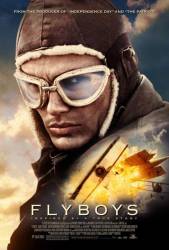Factual error: In the beginning of the movie William supposedly boards the train in Lincoln, Nebraska. All the vehicles in the train are from Europe and never rolled in the United States. (00:03:35)

Flyboys (2006)
Directed by: Tony Bill
Starring: James Franco, Jean Reno, Philip Winchester, Mac McDonald, Jennifer Decker, Scott Hazell
Factual error: The Zeppelin shot down in this movie is labeled L32. The real L32 was shot down over England (near Billericay) , rather than France, and during night raid, not in daylight.
Factual error: The film is set up until the USA enter the war, which was April 1917. The Germans always appear flying Fokker Dr.I triplanes, which flew for the first time in August and only appeared in any significant numbers over the front in November. Granted, the triplanes were a great way of letting the audience know who were the good and bad guys when so many similar-looking aircraft were together in the sky at the same time and in such haste.
Reed Cassidy: Some day it'll just end. Everyone will go home, get on with their lives. Tall grass will cover the battlefields. And all the pilots we've lost won't mean a damn thing.
Captain Thenault: Reports can be filed. But you want "justice"? You're the man in the air. You're the man with the gun.
Blaine Rawlings: You, uh, slip there, killer?
Question: The Dr. 1's are repeatedly shown opening their attack by diving down on their enemy. I know that Dr. 1's (because of their tri-wing configuration) had excellent climbing abilities, but it was hopeless at diving. So my question is: was this a common tactic for German pilots (specifically in the Dr. 1) to do this?
Question: Is it possible to shoot the pilot of an enemy bi-plane in mid-air with a handgun? I would have thought the high wind velocity would have blown the bullet sideways, but I'm hardly an expert.
Chosen answer: Biplanes were not very fast in flight. For instance a Sopwith Camel at about 5000 ft altitude had a cruise speed of approximately 100 mph. A Fokker had a cruise speed of about 95 mph. A typical WWI handgun could shoot 830 feet per second. With the distances between the planes as shown in the movie, a bullet could travel between the planes in less than half a second. The pilot would have to lead the target some, but he conceivably could hit the other pilot if close enough.





Answer: Easy answer. In WW1 and WW2 pilots would attack with the sun behind them as it made them very hard to spot. "Beware of the Hun in the sun" Once the missile age started it didn't matter.
stiiggy